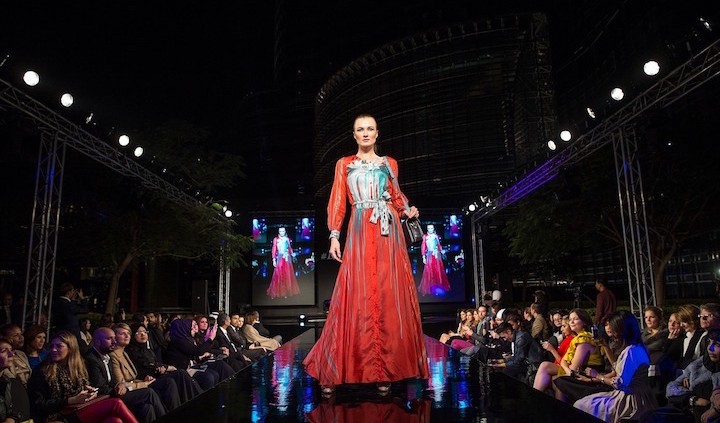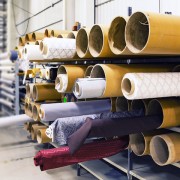3D-Printing in Fashion
John Lasseter said that “The art challenges the technology, and the technology inspires the art.” This quote is applicable now more than ever to the creative and burgeoning industry that is fashtech.
It is a common misconception that there are two types of thinkers in the world; a vertical thinker who is known for being analytical, careful and precise, and a lateral thinker, known for their creativity and risk-taking approach to find solutions.
The Information Age has shown that those once considered to have a certain way of thinking can combine their passion and interests, thus applying their own way of thinking to create innovative projects.
One area that this is becoming increasingly prevalent within is fashtec – fashion and technology.
2016 was an exciting year that welcomed the collaboration between fashion and technology. New York’s annual Met Gala ceremony – one of the most prestigious events of the global fashion calendar – focused its theme on the integration of technology with fashion, titled ‘Manus x Machina.’ The glamorous event treated guests to some elaborate innovations that would test your belief, including a Hussein Chalayan dress that requires the wearer to simply stand and observe as the dress applies itself to their body and transports them around the room. Another striking trend that was showcased at the Gala was clothing that has the ability to change colour to suit its surroundings and accessories.
But how are these contraptions being produced? It is safe to presume even the most respected fashion designers are limited to what they can do with a sewing machine or the humble needle and thread.
The 3D-printing phenomenon has been assisted by breakthroughs in different industries such as medtech, automotive and aerospace, allowing those to design and create prosthetic limbs and organs, as well as more efficient vehicle components. But these are all very specific to those involved in their respected industries. Where 3D-printing really touches the masses is through its recent application in the fashion industry and the endless possibilities it can bring to the table.
You may be thinking to yourself that 3D-printing in fashion is nothing new, and you’re somewhat right. 3D-printing has been widely utilised for producing incredibly detailed and luxurious accessories, including jewellery and shoes, the reason being that these accessories are mostly solid objects that require very little flexibility – particularly if they are to be used only for presentation.
What’s most exciting about the latest breakthroughs in fashtech is the ability for 3D printers to print actual fabric. Bradley Rothenberg, co-founder and CEO of nTopology (a 3D-printing company), is developing software which allows one to use a 3D printer to create thousands of miniature interlocking nylon mechanisms, which upon being attached in a certain formation creates a flexible material that can be used for wearable clothing.
In a similar field, Lina Wassong, a German fashion designer and engineer, develops innovative technologies and integrates them with her passion for design and fashion. [Wassong]’s work explores how we will seamlessly connect and communicate with electronic components in the future.
Wassong will be speaking at this year’s highly anticipated Dublin Tech Summit (DTS) on her experience in fashion and technology, how she utilises 3D printing for her designs and her views on the future of the trend.
As seen at last year’s Met Gala, 3D-printed clothing is effectively the current apex of haute couture. As it stands, the concept of printing apparel is an exclusive ability in the hands of the top brands, including Ralph Lauren, Viktor&Rolph and Francis Bitonti. 3D printers – granted they have been on the scene a few years now – are still a very expensive commodity, and are even more expensive to run. But where there is opportunity, there are those willing to invest time and capital. Just like in the early days of the sewing machine and computers, the concept of the 3D printer trickling down to the masses and becoming a household item seems unlikely.
But as fashion has the dynamic ability to be both timeless and brief, the demand for advancements in the technology used in the fashion industry is likely to continue to grow and become more widely available.
Find out more about the future of fashion and technology from Lina Wassong, Ray Noori and other tech icons at this year’s DTS on February 15th & 16th 2017.
DTS tickets are available now. Click here to secure yours.
Evan O’Gorman







Trackbacks & Pingbacks
chinese dating show https://freewebdating.net/
totally free dating sites local https://allaboutdatingsites.com/
best single sites https://datingwebsiteshopper.com/
12 single dating site https://onlinedatinghunks.com/
dating meet singles https://onlinedatingsuccessguide.com/
good dating site https://onlinedatingsurvey.com/
online date https://sexanddatingonline.com/
eu mature https://free-dating-sites-free-personals.com/
online chatting sites https://jewish-dating-online.net/
online dating sites for free 100% https://freewebdating.net/
coursework masters https://courseworkdomau.com/
coursework resources https://buycoursework.org/
coursework moderation https://teachingcoursework.com/
coursework info https://coursework-expert.com/
coursework paper https://courseworkinfotest.com/
coursework writer https://courseworkdownloads.com/
coursework master https://mycourseworkhelp.net/
coursework writing uk https://writingacoursework.com/
coursework service https://courseworkninja.com/
buy coursework https://brainycoursework.com/
2resentful
paper writing service college https://studentpaperhelp.com/
help with paper writing https://ypaywallpapers.com/
buy resume paper https://premiumpapershelp.com/
papers help https://papercranewritingservices.com/
custom paper services https://essaybuypaper.com/
buy cheap papers https://writemypaperquick.com/
paper writing service reviews https://buyessaypaperz.com/
do my college paper https://writingpaperservice.net/
academic paper writers https://cheapcustompaper.org/
need help writing my paper https://top100custompapernapkins.com/
write my custom paper https://doyourpapersonline.com/
can you write my paper for me https://write-my-paper-for-me.org/
best write my paper website https://writepapersformoney.com/
buy writing paper https://paperwritinghq.com/
will you write my paper for me https://uktermpaperwriters.com/
do my papers https://sociologypapershelp.com/
gay chat rpulete https://gaymanchatrooms.com/
snap chat gay boy cums https://gayinteracialchat.com/
gay dirty chat https://free-gay-sex-chat.com/
gay chat roulette adult https://gaymusclechatrooms.com/
gay chat rooms no registration https://gaychatnorules.com/
gay chat apps for pc https://gayphillychat.com/
gay local chat https://chatcongays.com/
gay chat phone line locker https://gay-live-chat.net/
gay men webcame and chat https://gaychatspots.com/
gay wire chat looking https://gaychatcams.net/
video gay chat https://newgaychat.com/
secure online casino https://casinosonlinex.com/
gta online casino heist https://online2casino.com/
hard rock online casino https://onlinecasinos4me.com/
dating sites in usa https://onlinedatingservicesecrets.com/
dating seiten uster https://zonlinedating.com/
best internet dating websites https://virtual-online-dating-service.com/
dating site for https://freeadultdatingpasses.com/
dating chat site https://lavaonlinedating.com/
dating services contact china https://wowdatingsites.com/
free web date site https://datingpersonalsonline.com/
sites online dating https://speedatingwebsites.com/
plenty of fish dating https://online-internet-dating.net/
american dating https://adult-classifieds-online-dating.com/
best sites online dating https://adult-singles-online-dating.com/
local single https://onlinedatingbabes.com/
best dating apps https://freephotodating.com/
gay dating hamptonroads virginia https://datinggayservices.com/
gay foot fetish dating https://gayedating.com/
biden gay boyfriend dating https://gay-singles-dating.com/
vpn chrome https://rsvpnorthvalley.com/
apple vpn free https://free-vpn-proxy.com/
free pc vpn https://superfreevpn.net/
best price vpn https://imfreevpn.net/
best home vpn https://ippowervpn.net/
vpn server https://freehostingvpn.com/
buy vpn client https://shiva-vpn.com/
free mobile vpn https://freevpnconnection.com/
casino real money online https://casino8online.com/
river online casino https://all-online-casino-games.com/
online pa casino https://ownonlinecasino.com/
online casino tournaments https://onlineplayerscasino.com/
online casino sweepstakes https://casino-online-jackpot.com/
gta 5 online casino https://casino-online-roulette.com/
blackjack 21 online blackjack multiplayer casino https://vrgamescasino.com/
online casino best payouts https://1freeslotscasino.com/
online casino codes https://cybertimeonlinecasino.com/
online casino with free signup bonus real money https://internet-casinos-online.net/
free online casino no deposit https://free-online-casinos.net/
casino royale full movie online free https://9lineslotscasino.com/
online casino free bonus no deposit https://onlinecasinosdirectory.org/
777 online casino https://trust-online-casino.com/
las vegas casino online https://newlasvegascasinos.com/
online casino usa legal https://onlinecasinofortunes.com/
online casino free bonus no deposit https://firstonlinecasino.org/
gta online casino heist guide https://download-casino-slots.com/
dissertation help glasgow https://customthesiswritingservices.com/
dissertation writing uk https://dissertationhelperhub.com/
phd dissertation https://dissertationhelpspecialist.com/
dissertation statistics help https://writingadissertationproposal.com/
phd dissertation writing help https://customdissertationwritinghelp.com/
writing dissertation chapters https://businessdissertationhelp.com/
dissertation cover page https://bestdissertationwritingservice.net/
citing a dissertation https://writing-a-dissertation.net/
citing a dissertation https://examplesofdissertation.com/
mba dissertation help https://accountingdissertationhelp.com/
help writing dissertation https://dissertationhelpexpert.com/
dissertation help glasgow https://dissertationwritingcenter.com/
cheap dissertation help in los angeles https://helpwithdissertationwritinglondon.com/
dissertation writing services https://professionaldissertationwriting.com/
writing a doctoral dissertation https://professionaldissertationwriting.org/
2illiterate
dissertation writing services https://helpon-doctoral-dissertations.net/
find a dissertation https://dissertations-writing.org/
dissertation introduction https://mydissertationwritinghelp.com/
dissertation writing tutors https://help-with-dissertations.com/
what is a dissertation https://dissertationwriting-service.com/
phd dissertation writing service https://buydissertationhelp.com/
igt slots online for free https://slotmachinegameinfo.com/
real money slots https://www-slotmachines.com/
slots blaze casino https://download-slot-machines.com/
willy wonka slots https://beat-slot-machines.com/
slotomania slots https://slot-machine-sale.com/
123 slots https://slotmachinesforum.net/
my vegas slots free chips https://slotmachinesworld.com/
jackpotjoy slots https://pennyslotmachines.org/
vegas world slots for free https://candylandslotmachine.com/
big win vegas slots https://freeonlneslotmachine.com/
i won $4 at penny slots https://2-free-slots.com/
gay dad dating game https://speedgaydate.com/
indian gay chat https://gaytgpost.com/
macro sonic dating sim gay https://gaypridee.com/
popular gay chat 360 https://bjsgaychatroom.info/
gay dating show youtube https://gaysugardaddydatingsites.com
logo gay dating series https://gayfade.com
#ИМЯ? https://speedgaydate.com
gay dudes strong bo odor dating sites https://gayprideusa.com
the best gay dating sites https://gay-buddies.com
gay hook up dating site https://gaypridee.com
3minolta
what colleges require sat essay https://windowsvpns.com/
essay writer https://vpn4torrents.com/
how to write a literary analysis essay https://vpnsrank.com/
love essay https://vpnshroud.com/
essay synonym https://vpn4home.com/
mla format essay heading https://thebestvpnpro.com/
how to write a hook for an essay https://tjvpn.net/
highschool essay https://topvpndeals.net/
essay reading https://choosevpn.net/
what is problem solving in critical thinking https://uncriticalthinking.com/
what are the four elements of critical thinking? https://criticalthinking2020.net/
definition of critical thinking articles https://criticalthinkinginstitute.com/
three stages of critical thinking https://criticalthinkingbasics.com/
free gamer dating gay https://gaysugardaddydatingsites.com/
pr gay dating site india https://gayfade.com/
advice for gay dating https://gayprideusa.com/
writing an essay intro https://checkyouressay.com/
how write an essay https://howtowriteessaytips.com/
easy essay writing https://yoursuperessay.com/
write a conclusion for an essay https://topessayswriter.com/
writing essay conclusion https://anenglishessay.com/
symptoms of keto flu https://ketogendiets.com/
keto protein https://ketogenicdietinfo.com/
keto bread crumbs https://ketogendiet.net/
keto dressing https://ketogenicdiets.net/
online casino best payouts https://casinosonlinex.com/
online casino betting https://casinoonlinet.com/
online casino ideal betaling https://online2casino.com/
free online casino https://onlinecasinos4me.com/
online casino for malaysian https://conline-casinos-hub.com/
hallmark online casino https://casinogamesmachines.com/
mohegan online casino https://onlinecasinoad.com/
ignition casino online chat https://casinoonlinek.com/
kinky sex games https://cybersexgames.net/
Comments are closed.